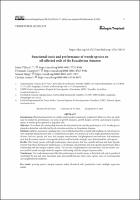Mostrar el registro sencillo del ítem
Functional traits and performance of woody species on oil- affected soils of the Ecuadorian Amazon
| dc.contributor.author | Villancis, Jaime | |
| dc.contributor.author | Casanoves, Fernando | |
| dc.contributor.author | Hang, Susana | |
| dc.contributor.author | Armas, Cristina | |
| dc.date.accessioned | 2023-11-08T18:12:47Z | |
| dc.date.available | 2023-11-08T18:12:47Z | |
| dc.date.issued | 2023-10 | |
| dc.identifier.uri | https://repositorio.catie.ac.cr/handle/11554/12352 | |
| dc.description.abstract | Tropical forests cover 10 % of the terrestrial surface and account for 50 % of worldwide tree diversity (Mayaux et al., 2005). More than half of tropical forest areas are composed of tropical rainforests, which are characterized by a high diversity of tree species (Lewis et al., 2009). Tropical rainforests have a significant influence on global patterns of biodiversity, ecosystem ecology, productivity, and biogeochemical cycles (Malhi, 2010). According to Guevara-Andino et al. (2019) in the Ecuadorian Amazon rainforest there are 2296 tree species; however, approximately 4.2 million hectares of this ecosystem have been impacted by many anthropogenic activities related to oil extraction (opening of new roads, construction of platforms, mud and drill cutting cells, contaminated soil treatment units, and settlement of camps and heliports) (Rivera-Parra et al., 2020). These activities have resulted in high deforestation, acceleration of soil erosion, decrease in water infiltration, increase in superficial runoff (Bertzky et al., 2011), and reduction of fauna species (Arroyo-Rodríguez et al., 2007; Pozo-Rivera et al., 2023).In response, the Ecuadorian government has implemented reforestation programs on sites affected by oil extraction processes since 2000 (Villacís, 2016). Reforestation activities began with the production of seedlings in plant nurseries, where various native and exotic tree species are produced (primarily timber, fruit, and ornamental plants), later, seedlings are transplanted into the affected soils when reach 30 cm in height. Studies to evaluate the most suitable species for reforestation sites (previously affected by oil extraction processes) have been conducted in plant nurseries (Villacís, Armas et al., 2016), as well as in open-field affected sites (Villacís, Casanoves et al., 2016). | es_ES |
| dc.format.extent | 13 paginas | es_ES |
| dc.language.iso | en | es_ES |
| dc.publisher | Revista de Biologia Tropical | es_ES |
| dc.relation.uri | https://revistas.ucr.ac.cr/index.php/rbt/article/view/50333 | |
| dc.subject | Especies||species||espécie||espèce | es_ES |
| dc.subject | Ciencias ambientales||environmental sciences||Ciências do ambiente||sciences de l'environnement | es_ES |
| dc.subject | Análisis del suelo||soil analysis||análise do solo||analyse de sol | es_ES |
| dc.subject | Conservación de la madera||wood preservation||preservação da madeira||préservation du bois | es_ES |
| dc.subject | Conservación de la madera||wood preservation||preservação da madeira||préservation du bois | es_ES |
| dc.subject.other | Sede Central | es_ES |
| dc.title | Functional traits and performance of woody species on oil- affected soils of the Ecuadorian Amazon | es_ES |
| dc.type | Artículo | es_ES |
| dc.creator.id | 0000-0001-7752-8506 | es_ES |
| dc.creator.id | 0000-0003-0356-8075 | es_ES |
| dc.creator.id | 0000-0003-4017-7057 | es_ES |
| dc.creator.id | 0000-0001-8765-9382 | es_ES |
| dc.identifier.status | openAccess | es_ES |
| dc.subject.sdg | ODS 11 - Ciudades y comunidades sostenibles | es_ES |
| dc.subject.sdg | ODS 12 - Producción y consumo responsables | es_ES |
| dc.subject.sdg | ODS 15 - Vida de ecosistemas terrestres | es_ES |


